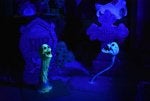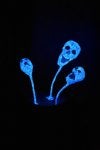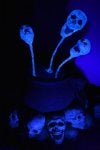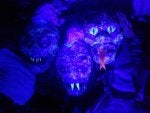Hi Everyone. I'm using black-light paint for the first time. I got it at Spirit last year. Is black-light paint suppose to be thin? This is really opaque. Thanks!

HauntedHostess
Discussion starter
66 posts
·
Joined 2017
- Add to quote
Hi Everyone. I'm using black-light paint for the first time. I got it at Spirit last year. Is black-light paint suppose to be thin? This is really opaque. Thanks!
3,111 posts
·
Joined 2008
I don't know what Spirit's is like but the cheaper stuff is generally pretty thin.You may want to try two or more coats. Watch for brushstrokes that might be visible when it dries.
IIdeally you would want to use that to your advantage and paint over a white background, not the black everyone usually thinks of. This really helps the paint "pop."
IIdeally you would want to use that to your advantage and paint over a white background, not the black everyone usually thinks of. This really helps the paint "pop."
HauntedHostess
Discussion starter
66 posts
·
Joined 2017
Thank you Screaming Demons! This is my first time using it. I did paint on white background and I think I'll get the black-light out tomorrow. I never thought of checking for brush strokes. Good idea! I'll use up what I have of this paint and maybe try a different brand next time. Thanks for the pointers!
1,532 posts
·
Joined 2015
I have tried lots of different glow in the dark paints and quite frankly they all kind of suck. The best I have found is Wildfire. It's not cheap and it's less thin but still streaky and requires several coats. The spray paints are bad too, require lots of coats, and don't glow for very long or very brightly. I'm more going for glowing under blacklight but on G.i.t.D. stuff I want G.i.t.D. paint because just using UV paint bothers me.
HauntedHostess
Discussion starter
66 posts
·
Joined 2017
Thank you lilibat, For the all the info. I don't feel so bad about it going on thin now. I'll definitely try a different one next time and avoid the sprays. I hate wasting stuff so I'll finish using it up and try Wildfire next time.
HauntedHostess
Discussion starter
66 posts
·
Joined 2017
Thanks Wolfman, I just read something about JoAnns' neon paint working good too.
1,269 posts
·
Joined 2006
The kind of blacklight also can make a big difference. Never bother with the classic light bulb versions. Use florescent tubes. They use a different gas inside that produces an Ultra-violet light. The black light bulbs just use dark purple glass. It's more of a filter, and does very little to excite phosphorescent paint.
HauntedHostess
Discussion starter
66 posts
·
Joined 2017
HalloweenBob, Thanks! I did not know that. I have a florescent light. But, I will not buy any bulbs and expect a good result.
803 posts
·
Joined 2016
This is the first year I tried using the UV (glow) paint. I did a lot of research, tried a lot of various paints, and this is my advice for you. Stay away from the stuff sold at the big box stores, it doesn’t work. The two paints I would recommend are ProFX by GloMania or Wildfire Luminescent Paint by Modern Masters. The ProFX is nearly 2x the cost of Wildfire but it degrades far less rapidly when exposed to sun light. The Wildfire paint stopped illuminating after about 2 months of exposure while the ProFX is still burning bright after 5 months+. Regardless all manufactures tell you not to expose it to sunlight as the UV rays will degrade the crystals in the paint. The paint is rather thick and opaque but if you use the “daytime invisible” paint it will appear clear with a slight sheen when dry (reference attached photo). The glowing properties of the paint work best on white or light surfaces. It can be thinned with water, I use a 50:50 mixture and applied it with a brush however you can also use it in an airbrush if you need to spray it. The paint glows best if charged by “true” blacklights or sunlight. I’ve been using a 9W LED blacklight by Feit Electric. The bulb isn’t cheap ($15 +-) but it charges the paint really fast and the paint glows really bright. Regardless of how the paint is charged it will only glow for about 10-15 minutes without a blacklight source. With a blacklight it will glow continuously. The photos show the paint during the day, when charged (no light source) and when illuminated with a blacklight. Hope this helps.
Attachments
-
69.9 KB Views: 362
-
9.5 KB Views: 302
-
23.3 KB Views: 585
-
9.5 KB Views: 338
-
14.3 KB Views: 324
4,324 posts
·
Joined 2004
As a child of the '60's, I am something of a Black Light aficionado; you know, hippies, lava lamps, UV Posters, Jimi Hendrix... I've always been fascinated and have always used it. Like In cooking, no such thing as too much garlic and ginger, on Halloween, no such thing as too much Black Light. We use a Hauted Ouija Board that glows, and it's a big hit every year.
As for your query, it depends on what you want to glow. Rust oleum makes an excellent Spray Paint with a strong reaction and long glow time in darkness. Under UV, you may want to tone it down a bit. We use it on the black craft paper lining in our Haunted Cave, and it's easy to apply too much. Not exactly el-cheapo, but, hey, ya get what ya pay for...
As for your query, it depends on what you want to glow. Rust oleum makes an excellent Spray Paint with a strong reaction and long glow time in darkness. Under UV, you may want to tone it down a bit. We use it on the black craft paper lining in our Haunted Cave, and it's easy to apply too much. Not exactly el-cheapo, but, hey, ya get what ya pay for...
4,324 posts
·
Joined 2004
I'm really glad you started this post, 'cause it's got me thinking...I'm going to use the Rustoleum product (very sparingly) on our tombstones. For a few seasons, now, I've wanted to add something there, just didn't know what...
HauntedHostess
Discussion starter
66 posts
·
Joined 2017
That sounds like a neat idea! I bet it would give it a eerie glow!
8 posts
·
Joined 2015
Home Depot and Lowe's both sell the 48" fluorescent black light tubes. I have two shop lights in my garage that I put 4 of the tubes in. They put out a great deal of UV light which will make that black light paint from Spirit glow like crazy. I use the black light paint from Spirit too. The neon colored latex paint from craft stores works good too. The lighter colors (yellow, orange, pink) show up best. Darker colors (blue, violet) don't show up as well.
HauntedHostess
Discussion starter
66 posts
·
Joined 2017
Thanks for the pointers. I noticed that about the colors too. 
HauntedHostess
Discussion starter
66 posts
·
Joined 2017
Skeleton Crew, Those Skulls are amazing! Thank you for all the info. I'm using this paint inside so I won't have to worry about Sun exposure but it's good to know for our outside decorations. This is great info. Thanks again!
HauntedHostess
Discussion starter
66 posts
·
Joined 2017
Hi Wolfman, We are making a giant Jack In The Box Prop with someone inside. The four sides of the box are made of canvas with Gesso (sp?) on it. I was painting the front of the box. We took a black light over it the other day and it seems to be glowing ok. But definitely can see the brush strokes so need a couple more coats of paint.
413 posts
·
Joined 2012
A couple years ago I used several 48" fluorescent black lights from ADJ to light our haunt, and I airbrushed several props with fluorescent paint from Createx. I also used some Krylon fluorescent paint on the walls to spray cob webbing.
![]()
The props really popped with the Createx but the Krylon didn't react very well. The following images show how vibrant they looked.
![Image]()
![Image]()

The props really popped with the Createx but the Krylon didn't react very well. The following images show how vibrant they looked.
HauntedHostess
Discussion starter
66 posts
·
Joined 2017
Wow! That looks nice! There are no streaks either. How many coats did you have to use?A couple years ago I used several 48" fluorescent black lights from ADJ to light our haunt, and I airbrushed several props with fluorescent paint from Createx. I also used some Krylon fluorescent paint on the walls to spray cob webbing.
View attachment 471249
The props really popped with the Createx but the Krylon didn't react very well. The following images show how vibrant they looked.
![Image]()
![Image]()
413 posts
·
Joined 2012
I used an airbrush so the spray was consistent. But the paint has to be thinned out so it takes a few passes.
9 posts
·
Joined 2017
In almost all situations, blacklight paint will yield the brightest "glow" (fluorescence) if you first apply a WHITE primer coat. Blacklight (UV reactive) paint is almost always thin, but typically yields best results if you paint it over a layer of white. The reason is that the white reflects some of the UV light through the blacklight paint, making the effect brighter. I have co-owned/operated a blacklight mini-golf course and a blacklight charity haunt, and when using blacklight paint we typically apply a white primer coat, then two coats of the blacklight paint. If your items are going to be outdoors, you need to apply some kind of clear coat over the blacklight paint. *It is very important to note that you need to be very selective when choosing a clear coat. It's counter-intuitive, but when a clear coat says "UV protection" (or something similar), using it over blacklight reactive paint will actually hurt the amount of "glow' achieved with the paint. These clear coats are made to protect objects from the UV rays of the sun, which means THEY BLOCK UV RAYS! That is the exact opposite of what you want. We've had good luck with "Minwax Water Based Polycrylic Protective Finish" (available at Home Depot). We usually apply one thick coat of the Polycrylic. If your objects are going outside, you need to reapply the Polycrylic every year.
Others have mentioned that the type of blacklight you use is important, and I think they are absolutely correct. The amount of other (non-blacklight) light in the area is also very important. The darker you can make the area, the better results you will have with your blacklight reactive objects. If you're a fan of blacklight haunts and attractions, or want to learn more about using blacklights in attractions, we recently started a blog called:
BLACKLIGHT AMUSEMENT BLOG
It's totally free, and we'd love to have some home haunters among our readers!
Best of luck with your blacklight haunting!
![]()
![]()
![]()
![]()
Others have mentioned that the type of blacklight you use is important, and I think they are absolutely correct. The amount of other (non-blacklight) light in the area is also very important. The darker you can make the area, the better results you will have with your blacklight reactive objects. If you're a fan of blacklight haunts and attractions, or want to learn more about using blacklights in attractions, we recently started a blog called:
BLACKLIGHT AMUSEMENT BLOG
It's totally free, and we'd love to have some home haunters among our readers!
Best of luck with your blacklight haunting!




9 posts
·
Joined 2017
In almost all situations, blacklight paint will yield the brightest "glow" (fluorescence) if you first apply a WHITE primer coat. Blacklight (UV reactive) paint is almost always thin, but typically yields best results if you paint it over a layer of white. The reason is that the white reflects some of the UV light through the blacklight paint, making the effect brighter. I have co-owned/operated a blacklight mini-golf course and a blacklight charity haunt, and when using blacklight paint we typically apply a white primer coat, then two coats of the blacklight paint. If your items are going to be outdoors, you need to apply some kind of clear coat over the blacklight paint. *It is very important to note that you need to be very selective when choosing a clear coat. It's counter-intuitive, but when a clear coat says "UV protection" (or something similar), using it over blacklight reactive paint will actually hurt the amount of "glow' achieved with the paint. These clear coats are made to protect objects from the UV rays of the sun, which means THEY BLOCK UV RAYS! That is the exact opposite of what you want. We've had good luck with "Minwax Water Based Polycrylic Protective Finish" (available at Home Depot). We usually apply one thick coat of the Polycrylic as our final coat. If your objects are going outside, you need to reapply the Polycrylic every year.
Others have mentioned that the type of blacklight you use is important, and I think they are absolutely correct. The amount of other (non-blacklight) light in the area is also very important. The darker you can make the area, the better results you will have with your blacklight reactive objects. If you're a fan of blacklight haunts and attractions, or want to learn more about using blacklights in attractions, we recently started a blog called:
BLACKLIGHT AMUSEMENT BLOG
It's totally free, and we'd love to have some fellow Halloween fanatics among our readers!
Best of luck with your blacklight haunting!
Here's a few quick picks from our old blacklight haunt:
![]()
![]()
![]()
Others have mentioned that the type of blacklight you use is important, and I think they are absolutely correct. The amount of other (non-blacklight) light in the area is also very important. The darker you can make the area, the better results you will have with your blacklight reactive objects. If you're a fan of blacklight haunts and attractions, or want to learn more about using blacklights in attractions, we recently started a blog called:
BLACKLIGHT AMUSEMENT BLOG
It's totally free, and we'd love to have some fellow Halloween fanatics among our readers!
Best of luck with your blacklight haunting!
Here's a few quick picks from our old blacklight haunt:



HauntedHostess
Discussion starter
66 posts
·
Joined 2017
Thanks Tiki Storm for all the great info. Everyone makes this forum such a great wealth of knowledge!
234 posts
·
Joined 2016
Wolfman (or anyone else),
You wrote "Rust oleum makes an excellent Spray Paint with a strong reaction and long glow time in darkness" - What is it called exactly? Or can you post a picture?
I'm looking at doing a graveyard display and only want to do WHITE as the "color" that pops in the blacklight. Also, are there good spider web products that will pop in blacklight or do you have essentially have to paint EVERYTHING you want to glow?
Thanks in advance,
Scarab
You wrote "Rust oleum makes an excellent Spray Paint with a strong reaction and long glow time in darkness" - What is it called exactly? Or can you post a picture?
I'm looking at doing a graveyard display and only want to do WHITE as the "color" that pops in the blacklight. Also, are there good spider web products that will pop in blacklight or do you have essentially have to paint EVERYTHING you want to glow?
Thanks in advance,
Scarab
234 posts
·
Joined 2016
I'm looking to do a graveyard with skeletons and tombstones and use a black light to make them pop. What are my options to make those things pop in a white/opaque color?
Scarab
Scarab
234 posts
·
Joined 2016
Another thing,
Why do white t-shirts pop in black light but not the white fake spider web-like cotton/polyester I bought from Wallyworld? Do t-shirts pop due to the fact they have been washed in detergent that contains phosphors?
Scarab
Why do white t-shirts pop in black light but not the white fake spider web-like cotton/polyester I bought from Wallyworld? Do t-shirts pop due to the fact they have been washed in detergent that contains phosphors?
Scarab
374 posts
·
Joined 2013
Because the tshirt is probably cotton or cotton based. The spiderwebs are generally polyester, which is plastic based, and plastic don't always fluoresce.
4,324 posts
·
Joined 2004
Whats the secret to taking good black light photos with a phone?
Attachments
-
29.1 KB Views: 249
5 posts
·
Joined 2024
I use a mask to keep UV protection off of the light/white backed fluorescent paint areas and instead only over the dark contrast areas to prevent fading. And do the reverse with the matte protective (non reflective non-uv blocking on the fluorescent parts. This increases contrast more, and longitivity. Of course I am a horror painter who has a background in working and acting in haunts rather than an active haunter. So my techniques may be too labor intensive when you have a looming amount of props and stages to cover. Not a good idea two months before October. 😉
-
?
-
?
-
?
-
?
-
?
-
?
-
?
-
?
-
?
-
?
-
?
-
?
-
?
-
?
-
?
-
?
-
?
-
?
-
?
-
?
- posts
- 2M
- members
- 89K
- Since
- 2002
Halloween forum - Keeping the Halloween spirit alive 365 days a year. Discuss decorations, costumes and more!









